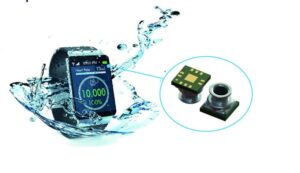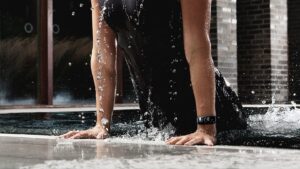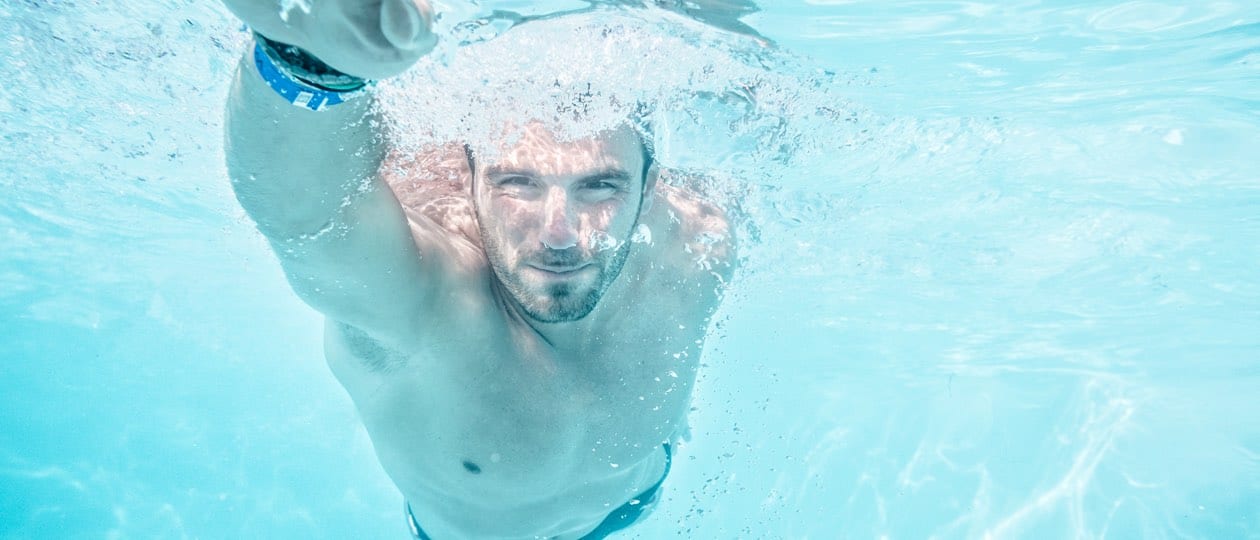The Samsung Gear Fit2 Pro launched in September 2017 is the first device in the Gear Fit family to have a water resistance rating of 5 ATM[1], thanks in part to ST’s new LPS33HW pressure sensor. The Gear Fit2 Pro was well received by the press because it took what everyone loved about the Gear Fit2 introduced in 2016, and improved on it by adding features like a swim tracker, continuous heart monitoring, and a new strap with a more secure clasp, among many others. It is also one of the few wristband trackers with a bright AMOLED screen as well as a built-in GPS, which has proven essential for jogging aficionados.
2017 is a milestone year for fitness trackers because experts finally recognized the precision and reliability of their measurements. For instance, Consumer Reports acknowledged that “fitness trackers are more accurate than ever” and the School of Medicine of Stanford University came to the conclusion that their heart rate monitoring was very reliable. These numerous breakthroughs are possible because sensors keep on getting more precise and powerful. One great example of this trend is the LPS33HW, ST’s barometer that uses a water-resistant package to ensure that new applications, like tracking strokes and laps in a swimming pool, become possible.
https://www.youtube.com/watch?v=kIbp2nzMPjs
How did the LPS33HW Become Waterproof?
Until recently, the very structure of pressure sensors prevented them from running under water. These devices measure the atmospheric pressure to determine the user’s altitude and calculate whether that person is climbing up or down a flight of stairs for instance, which is essential in the case of an activity tracker. To be able to do so, the MEMS (Micro Electro Mechanical System) barometer uses a membrane, located inside the packaging, which bends upward and downward depending on the pressure changes. However, for such a system to be possible, there must be an air vent aperture that lets the air pass through. Indeed, an entirely sealed component wouldn’t be able to detect pressure changes accurately.
The problem with this design is that even if the rest of the system is waterproof, the vent can let water inside the package, destroying the membrane and wreaking havoc on the IC underneath. The LPS33HW uses an elegant solution to this problem in the form a gel. Indeed, the substance completely fills the inside of the barometer to keep the water out of the device, yet it doesn’t negatively affect the movement of the membrane, ensuring precise measurements. It also coats the wires connecting the sensing element to the IC, protecting them from the environment to guarantee the integrity of the information transmitted.
Why is the LPS33HW More Robust?

However, waterproofing the pressure sensor is not enough when engineers are designing a fitness tracker for everyday use. People are in contact with harsh environments, brutal temperatures, and chemicals that could potentially damage the coating protecting the pressure sensor. In many competing devices, the gel can’t really tolerate these attacks by foreign agents over an extended period of time. The adhesives inside these devices soften, and the gel no longer hermetically shields the structure, leading to a shorter lifespan, higher maintenance costs, and diminishing performances.
It’s to avoid these issues that Samsung uses ST’s LPS33HW in its Gear Fit2 Pro. The gel in the MEMS is resistant to chlorine, bromine, salt water, soaps, and detergents. As a result, swimming in public pools, or at sea, or just taking a shower every day with the Gear Fit2 Pro won’t compromise its integrity or lifespan. ST’s own testing has proven that the sensor has absolutely no deterioration or degradation of performance over time when exposed to these chemicals. In fact, the LPS33HW is so reliable it also works in industrial applications, like gas meters. Furthermore, since the component operates at temperatures ranging from –40 ºC to +85 ºC, Gear Fit2 Pro users really have nothing to fear.
Why Is the LPS33HW More Accurate?
Accuracy is also a fundamental aspect of a MEMS barometer, but not all devices are equal. As we saw, a membrane placed on top of the IC bends according to the changes in atmospheric pressure. To quantify the element’s distortion, manufacturers put a Wheatstone Bridge on this diaphragm, and as it moves up or down, the system detects positive or negative changes in electrical resistance to determine the pressure changes. It is also crucial that the device integrates a thermometer to monitor the changes of temperatures that can sometimes occur at different elevations, which will be used to compensate the initial reading and provide even more accurate results thanks to the embedded compensation algorithm of the LPS33HW.
The LPS33HW offers tremendous accuracy because, unlike other competing devices, it uses piezoresistors that are able to sense the slightest changes in electrical resistance, thus providing incredibly more precise results. This explains why the device has a wide pressure range spanning from 260 hPa to 1,260 hPa. In fact, ST’s barometers are often found in devices like the multi-sport PIQ sensor we previously covered in the Life.Augmented Blog, because the company’s piezoresistive structure offers outstanding accuracy. Furthermore, the LPS33HW’s IC is able to output 24-bit values and reach an Output Data Rate (ODR) of 75 Hz, meaning that the application will have a continuous flow of precise data to make critical decisions and calculate results that will shape the user’s experience.
The ST Advantage for Samsung and for You

Specifications are only one piece of the puzzle though. What they won’t tell you is how ST designs its products to facilitate the life of engineers and manufacturers, regardless of the volume and devices they produce. For instance, manufacturing processes will put pressure sensors under extreme heat during soldering. This will cause the sensing element to bend, and a common component will take about seven days before it recovers and is able to output accurate information again. However, the LPS33HW is unique because it has a soldering drift of only ±2 mbar, meaning half that of competing products. Hence, there’s a lot less distortion, and the ST device is able to recover in just 72 hours. As a result, production times decrease, and manufacturers can ship their products quicker.
To also help engineers develop their applications faster, ST offers Hardware Abstraction Layers for Android and Linux, which include drivers and the frameworks necessary to set up the LPS33HW as well as capture and parse its data. An evaluation board, the STEVAL-MKI183V1, is also in the works. It will house an LPS33HW and sit on top of a MEMS development tool, like the STEVAL-MKI109V3, to offer a very affordable way to start testing the barometer, work on an application, and jump-start designs. This is particularly important for smaller teams that must begin prototyping quickly and efficiently. Hence, the beauty of ST’s pressure sensor is its ability to feel right at home in a massive and impressive consumer device like the Gear Fit2 Pro, as well as the next Kickstarter project.
- To know more about the Samsung Gear Fit2 Pro, please visit Samsung’s website.
- To get more information on the LPS33HW, visit ST’s website.
- Gear Fit2 Pro has an ISO 22810:2010 certification for wristwatches of 5 ATM or 50 meters (165 feet) under defined conditions of pressure, time, velocity and temperature. This means that the device is safe to wear while walking in the rain or showering, and it may be used for shallow-water activities like swimming in a pool or the ocean. However, Gear Fit2 Pro should not be used for scuba diving, waterskiing, or other activities involving sudden temperature changes, high-velocity water activities or submersion below shallow depth. Rinse in fresh water and dry after use in seawater. ↩
